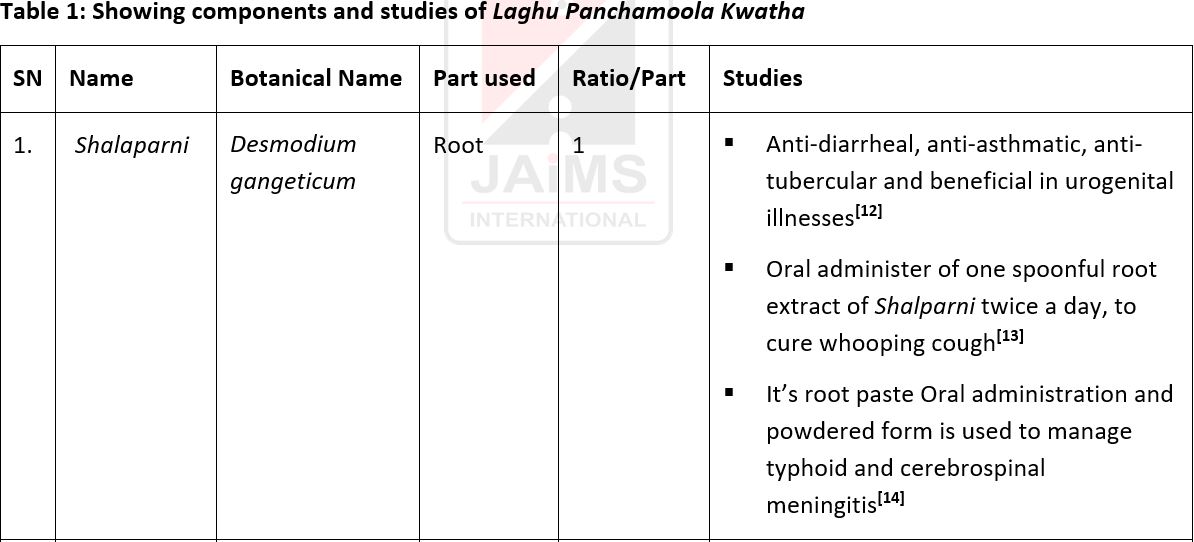Evidence based study to explore the benefits of breastfeeding and effect of Laghu Panchamool processed Cow milk compared to formula feed in infants
DOI:
https://doi.org/10.21760/jaims.10.6.45Keywords:
Breast milk, Cow milk, Formula feed, Immunity, Laghu Panchamoola, NutritionAbstract
Introduction: Nutritional status shows a vital role in determining the health status particularly in children. Nutritional deficiencies give rise to a number of morbidities, which in turn, may lead to increased mortality. Infants got perfect nutrition form mother breast milk due to protein, fat, vitamins, immunoglobulin and all baby essentials to develop. They all are available in a more digestible form than powdered milk. Health experts believe breastfeeding is the topmost dietetic option for infants, but it may not be an option for every woman. Decisions are based on health, lifestyle, and specific medical conditions. Methods: This study was completed by gathering the knowledge from classical Ayurvedic literature, pediatric magazines, research articles, guidelines and PubMed and Medline database. Results and Discussion: Currently available formula feeds have lack of immunoglobulins and do not match the complexity of breast milk. Formula feeds are more problematic on the infant’s gut and may produce various diseases in future. Conclusion: In Ayurvedic texts, Laghu Panchamoola processed cow milk is one of the best option in absence of breast milk. This formulation has Anti-helminthic, Anti-inflammatory, Anti-diarrheal, Anti-diabetic, Anti-oxidant, Anti-pyretic, Anti-tumor, Anti-asthmatic and Free radical scavenging properties along with best required nutrition.
Downloads
References
Stuebe A. The risks of not breastfeeding for mothers and infants. Rev Obstet Gynecol. 2009;2(4):222–31.
Klement E, Cohen RV, Boxman V, Joseph A, Reif S. Breastfeeding and risk of inflammatory bowel disease: a systematic review with meta-analysis. Am J Clin Nutr. 2004;80:1342–52.
Dell S, To T. Breastfeeding and asthma in young children. Arch Pediatr Adolesc Med. 2001;155:1261–5.
Van Acker J, de Smet F, Muyldermans G, Bougatef A, Naessens A, Lauwers S. Outbreak of necrotizing enterocolitis associated with Enterobacter sakazakii in powdered infant formulas. J Clin Microbiol. 2001;39:293–7.
Monetini L, Cavallo MG, Stefanini L, Ferrazzoli F, Bizzarri C, Marietti G, et al. Bovine beta-casein antibodies in breast- and bottle-fed infants: relevance in Type 1 diabetes. Horm Metab Res. 2002;34:455–9.
Fattal-Valevski A, Kesler A, Seal B, Nitzan-Kaluski D, Rotstein M, Mesterman R, et al. Outbreak of life-threatening thiamine deficiency in infants in Israel caused by defective soy-based formula. Pediatrics. 2005;115:223–8.
Weir E. Powdered infant formula and fatal infection with Enterobacter sakazakii. CMAJ. 2002;166.
Ostan M, Creţescu I, et al. Studies regarding the effect of boiling on cow milk quality with analysis of some physico-chemical characteristics and the somatic cell count. Res J Agric Sci. 2016;48(2).
Lamberti C, Baro C, et al. Effects of two different domestic boiling practices on the allergenicity of cow's milk proteins. J Sci Food Agric. 2018;98(6):2370–7. https://doi.org/10.1002/jsfa.8728
Curlej J, Zajác P, Capla J, Golian J, Benešová L, Partika A, et al. The effect of heat treatment on cow’s milk protein profiles. Foods. 2022;11:1023. https://doi.org/10.3390/foods11071023
Tripathi B. Astanga Hrdayam of Srimadvagbhata. Uttaratantra Chapter 1, Verse 20. Chaukhamba Sanskrit Pratishthan; 2009.
Trivedi PC. Medicinal plants: Ethnobotanical approach. Jodhpur: Agrobios (India); 2006. p. 278.
Ravi PRB, Sunitha S. Medicinal plant resources of Rudrakod Sacred Grove in Nallamalais, Andhra Pradesh, India. J Biodivers. 2011;2(2):75–89.
Richa SC. Taxa of family Fabaceae: potential medicinal value in Vindhya region, Uttar Pradesh, India. Int J Pharm Bio Sci. 2010;1(4):B46–53.
Ahirrao P, Jagtap A, Shirke S, Farnandes B. Comparative evaluation of aqueous and methanolic extracts of roots of Asparagus racemosus and whole plants of Uraria picta. Life Sci. 2007;108.
Rahman MM, Gibbons S, Gray AI. Isoflavanones from Uraria picta and their antimicrobial activity. Phytochemistry. 2007;68:1692–7.
Gavimath CC, Kulkarni SM, Raorane CJ, Gavade BG, Kalsekar DP, Ravishankar BE, et al. Antibacterial potentials of Solanum indicum Linn, Solanum xanthocarpum and Physalis minima. Int J Pharm Appl. 2012;3(4):414–8.
Abeer YI, Nermeen MS. Protective effect of Solanum indicum var. distichum extract on experimentally induced gastric ulcers in rats. Glob J Pharmacol. 2013;7(3):325–32.
Deb PK, Das N, Bhakta RGT. Evaluation of in-vitro antioxidant and anthelmintic activity of Solanum indicum Linn. berries. Indo Am J Pharm Res. 2013;3(2):4123–30.
Nadkarni KM. Indian Materia Medica. Vol I. 3rd ed. Mumbai: Popular Publication; 2009. p. 1156–8.
Gupta MP, Dutt S. Chemical examination of the seeds of Solanum xanthocarpum. II. Constituents. J Indian Chem Soc. 1938;15:95–100.
Tilwari A, Shukla NP, Devi U. Effect of five medicinal plants used in Indian system of medicines on immune function in Wistar rats. Afr J Biotechnol. 2011;10:16637–45.
Kiran B, Lalitha V, Raveesha KA. In vitro evaluation of aqueous and solvent extracts of Tribulus terrestris L. leaf against human bacteria. Int J Pharm Tech Res. 2011;3:1897–903.
Deepak M, Dipankar G, Prashanth D, Asha MK, Amit A, Venkataraman BV. Tribulosin and β-sitosterol-D-glucoside: the anthelmintic principles of Tribulus terrestris. Phytomedicine. 2002;9:753–6.
Li M, Qu W, Chu S, Wang H, Tian C, Tu M. Effect of the decoction of Tribulus terrestris on mice gluconeogenesis. Zhong Yao Cai. 2001;24:586–8.
Amin A, Lotfy M, Shafiullah M, Adeghate E. The protective effect of Tribulus terrestris in diabetes. Ann N Y Acad Sci. 2006;1084:391–401.
Agnivesha. Charaka Samhita. Vidyotini Hindi commentary by Sastri K, Chaturvedi G. 22nd ed. Varanasi: Chowkhamba Bharati Academy; 1993. Chikitsa Sthana 16/114. p. 504.
Sushruta M. Sushruta Samhita, Purvardha. Hindi commentary by Shastri A. 11th ed. Varanasi: Chaukhambha Sanskrit Sansthan; Sutra Sthana 38/67,68. p. 146.
Vagbhata. Ashtanga Hrudayam. Hindi translation by Vaidya L. New Delhi: Motilal Banarasidas; reprint 1977. Sutra Sthana 6/166–157. p. 59.















